- ▶
- Heaters/Source
- ▶
- Agilent Heaters and SensorsMass Spectrometry, Scientific Supplies & ManufacturingScientific Instrument Services 5973 Source Heater Tamper Resistant Allen Wrench 5973/5975 Quad Sensor 5985 Source Heater Assembly Agilent Interface Heater Assembly 5971 Interface Heater

- ▶
- Probes
- LiteratureApplication Notes Adsorbent Resins Guide Mass Spec Tips SDS Sheets FAQ MS Calibration Compound Spectra Manuals MS Links/Labs/ Organizations MS Online Tools Flyers on Products/Services Scientific Supplies Catalog About Us NextAdvance Bullet Blender® Homogenizer Protocols Micro-Mesh® Literature Instrumentation Literature Agilent GC/MS Literature SIS News / E-Mail Newsletter NIST MS Database - Update Notifications

- ▶
- Application NotesNote 103: EPA Method 325B, Novel Thermal Desorption Instrument Modification to Improve Sensitivity Note 102: Identification of Contaminants in Powdered Beverages by Direct Extraction Thermal Desorption GC/MS Note 101: Identification of Contaminants in Powdered Foods by Direct Extraction Thermal Desorption GC/MS Note 100: Volatile and Semi-Volatile Profile Comparison of Whole Versus Cracked Versus Dry Homogenized Barley Grains by Direct Thermal Extraction Note 99: Volatile and Semi-Volatile Profile Comparison of Whole vs. Dry Homogenized Wheat, Rye and Barley Grains by Direct Thermal Extraction GC/MS Note 98: Flavor and Aroma Profiles of Truffle Oils by Thermal Desorption GC/MS Note 97: Flavor Profiles of Imported and Domestic Beers by Purge & Trap Thermal Desorption GC/MS Note 96: Reducing Warping in Mass Spectrometer Filaments, with SISAlloy® Yttria/Rhenium Filaments Note 95: Detection of Explosives on Clothing Material by Direct and AirSampling Thermal Desorption GC/MS Note 94: Detection of Nepetalactone in the Nepeta Cataria Plant by Thermal Desorption GC/MS Note 93: Detection of Benzene in Carbonated Beverages with Purge & Trap Thermal Desorption GC/MS Note 92: Yttria Coated Mass Spectrometer Filaments Note 91: AutoProbe DEP Probe Tip Temperatures Note 90: An Automated MS Direct Probe for use in an Open Access Environment Note 89: Quantitation of Organics via a Mass Spectrometer Automated Direct Probe Note 88: Analysis of Silicone Contaminants on Electronic Components by Thermal Desorption GC-MS Note 87: Design and Development of an Automated Direct Probe for a Mass Spectrometer Note 86: Simulation of a Unique Cylindrical Quadrupole Mass Analyzer Using SIMION 7.0. Note 85: Replacing an Electron Multiplier in the Agilent (HP) 5973 MSD Note 84: Vacuum Pump Exhaust Filters - Charcoal Exhaust Traps Note 83: Vacuum Pump Exhaust Filters - Oil Mist Eliminators Note 82: Vacuum Pump Exhaust Filters Note 81: Rapid Bacterial Chemotaxonomy By DirectProbe/MSD Note 80: Design, Development and Testing of a Microprocessor ControlledAutomated Short Path Thermal Desorption Apparatus Note 79: Volatile Organic Compounds From Electron Beam Cured and Partially Electron Beam Cured Packaging Using Automated Short Path Thermal Desorption Note 78: A New Solution to Eliminate MS Down-Time With No-Tool-Changing of Analytical GC Columns Note 77: The Determination of Volatile Organic Compounds in VacuumSystem Components Note 76: Determination of the Sensitivity of a CRIMS System Note 75: An Apparatus for Sampling Volatile Organics From LivePlant Material Using Short Path Thermal Desorption Note 74: Examination of Source Design in Electrospray-TOF Using SIMION 3D Note 73: The Analysis of Perfumes and their Effect on Indoor Air Pollution Note 72: 1998 Version of the NIST/EPA/NIH Mass Spectral Library, NIST98 Note 71: Flavor Profile Determination of Rice Samples Using Shor tPath Thermal Desorption GC Methods Note 70: Application of SIMION 6.0 To a Study of the Finkelstein Ion Source: Part II Note 69: Application of SIMION 6.0 To a Study of the Finkelstein Ion Source: Part 1 Note 68: Use of a PC Plug-In UV-Vis Spectrometer To Monitor the Plasma Conditions In GC-CRIMS Note 67: Using Chemical Reaction Interface Mass Spectrometry (CRIMS) To Monitor Bacterial Transport In In Situ Bioremediation Note 66: Probe Tip Design For the Optimization of Direct Insertion Probe Performance Note 65: Determination of Ethylene by Adsorbent Trapping and Thermal Desorption - Gas Chromatography Note 64: Comparison of Various GC/MS Techniques For the Analysis of Black Pepper (Piper Nigrum) Note 63: Determination of Volatile and Semi-Volatile Organics in Printer Toners Using Thermal Desorption GC Techniques Note 62: Analysis of Polymer Samples Using a Direct Insertion Probe and EI Ionization Note 61: Analysis of Sugars Via a New DEP Probe Tip For Use With theDirect Probe On the HP5973 MSD Note 60: Programmable Temperature Ramping of Samples Analyzed ViaDirect Thermal Extraction GC/MS Note 59: Computer Modeling of a TOF Reflectron With Gridless Reflector Using SIMION 3D Note 58: Direct Probe Analysis and Identification of Multicomponent Pharmaceutical Samples via Electron Impact MS Note 57: Aroma Profiles of Lavandula species Note 56: Mass Spec Maintenance & Cleaning Utilizing Micro-Mesh® Abrasive Sheets Note 55: Seasonal Variation in Flower Volatiles Note 54: Identification of Volatile Organic Compounds in Office Products Note 53: SIMION 3D v6.0 Ion Optics Simulation Software Note 52: Computer Modeling of Ion Optics in Time-of-Flight mass Spectrometry Using SIMION 3D Note 51: Development and Characterization of a New Chemical Reaction Interface for the Detection of Nonradioisotopically Labeled Analytes Using Mass Spectrometry (CRIMS) Note 50: The Analysis of Multiple Component Drug Samples Using a Direct Probe Interfaced to the HP 5973 MSD Note 49: Analysis of Cocaine Utilizing a New Direct Insertion Probe on a Hewlett Packard 5973 MSD Note 48: Demonstration of Sensitivity Levels For the Detection of Caffeine Using a New Direct Probe and Inlet for the HP 5973 MSD Note 47: The Application Of SIMION 6.0 To Problems In Time-of-Flight Mass Spectrometry Note 46: Delayed Extraction and Laser Desorption: Time-lag Focusing and Beyond Note 45: Application of SIMION 6.0 to Filament Design for Mass Spectrometer Ionization Sources Note 44: The Design Of a New Direct Probe Inlet For a Mass Spectrometer Note 43: Volatile Organic Composition In Blueberries Note 42: The Influence of Pump Oil Purity on Roughing Pumps Note 41: Hydrocarbon Production in Pine by Direct Thermal Extraction Note 40: Comparison of Septa by Direct Thermal Extraction Note 39: Comparison of Sensitivity Of Headspace GC, Purge and Trap Thermal Desorption and Direct Thermal Extraction Techniques For Volatile Organics Note 38: A New Micro Cryo-Trap For Trapping Of Volatiles At the Front Of a GC Capillary Column Note 37: Volatile Organic Emissions from Automobile Tires Note 36: Identification Of Volatile Organic Compounds In a New Automobile Note 35: Volatile Organics Composition of Cranberries Note 34: Selection Of Thermal Desorption and Cryo-Trap Parameters In the Analysis Of Teas Note 33: Changes in Volatile Organic Composition in Milk Over Time Note 32: Selection and Use of Adsorbent Resins for Purge and Trap Thermal Desorption Applications Note 31: Volatile Organic Composition in Several Cultivars of Peaches Note 30: Comparison Of Cooking Oils By Direct Thermal Extraction and Purge and Trap GC/MS Note 29: Analysis Of Volatile Organics In Oil Base Paints By Automated Headspace Sampling and GC Cryo-Focusing Note 28: Analysis Of Volatile Organics In Latex Paints By Automated Headspace Sampling and GC Cryo-Focusing Note 27: Analysis of Volatile Organics In Soils By Automated Headspace GC Note 26: Volatile Organics Present in Recycled Air Aboard a Commercial Airliner Note 25: Flavor and Aroma in Natural Bee Honey Note 24: Selection of GC Guard Columns For Use With the GC Cryo-Trap Note 23: Frangrance Qualities in Colognes Note 22: Comparison Of Volatile Compounds In Latex Paints Note 21: Detection and Identification Of Volatile and Semi-Volatile Organics In Synthetic Polymers Used In Food and Pharmaceutical Packaging Note 20: Using Direct Thermal Desorption to Assess the Potential Pool of Styrene and 4-Phenylcyclohexene In Latex-Backed Carpets Note 19: A New Programmable Cryo-Cooling/Heating Trap for the Cryo-Focusing of Volatiles and Semi-Volatiles at the Head of GC Capillary Columns Note 18: Determination of Volatile Organic Compounds In Mushrooms Note 17: Identification of Volatile Organics in Wines Over Time Note 16: Analysis of Indoor Air and Sources of Indoor Air Contamination by Thermal Desorption Note 14: Identification of Volatiles and Semi-Volatiles In Carbonated Colas Note 13: Identification and Quantification of Semi-Volatiles In Soil Using Direct Thermal Desorption Note 12: Identification of the Volatile and Semi-Volatile Organics In Chewing Gums By Direct Thermal Desorption Note 11: Flavor/Fragrance Profiles of Instant and Ground Coffees By Short Path Thermal Desorption Note 10: Quantification of Naphthalene In a Contaminated Pharmaceutical Product By Short Path Thermal Desorption Note 9: Methodologies For the Quantification Of Purge and Trap Thermal Desorption and Direct Thermal Desorption Analyses Note 8: Detection of Volatile Organic Compounds In Liquids Utilizing the Short Path Thermal Desorption System Note 7: Chemical Residue Analysis of Pharmaceuticals Using The Short Path Thermal Desorption System Note 6: Direct Thermal Analysis of Plastic Food Wraps Using the Short Path Thermal Desorption System Note 5: Direct Thermal Analysis Using the Short Path Thermal Desorption System Note 4: Direct Analysis of Spices and Coffee Note 3: Indoor Air Pollution Note 2: Detection of Arson Accelerants Using Dynamic Headspace with Tenax® Cartridges Thermal Desorption and Cryofocusing Note 1: Determination of Off-Odors and Other Volatile Organics In Food Packaging Films By Direct Thermal Analysis-GC-MS Tech No. "A" Note 14: Elimination of "Memory" Peaks in Thermal Desorption Improving Sensitivity in the H.P. 5971 MSD and Other Mass Spectrometers - Part I of II Improving Sensitivity in the H.P. 5971 MSD and Other Mass Spectrometers- Part II of II Adsorbent Resins Guide Development and Field Tests of an Automated Pyrolysis Insert for Gas Chromatography. Hydrocarbon Production in Pine by Direct Thermal Extraction A New Micro Cryo-Trap for the Trapping of Volatiles at the Front of a GC Capillary (019P) - Comparison of Septa by Direct Thermal Extraction Volatile Organic Composition in Blueberry Identification of Volatile Organic Compounds in Office Products Detection and Indentification of Volatiles in Oil Base Paintsby Headspace GC with On Column Cryo-Trapping Evaluation of Septa Using a Direct Thermal Extraction Technique INFLUENCE OF STORAGE ON BLUEBERRY VOLATILES Selection of Thermal Desorption and Cryo-Trap Parameters in the Analysis of Teas Redesign and Performance of a Diffusion Based Solvent Removal Interface for LC/MS The Design of a New Direct Probe Inlet for a Mass Spectrometer Analytes Using Mass Spectrometry (CRIMS) Application of SIMION 6.0 to Filament Design for Mass Spectrometer Ionization Sources A Student Guide for SIMION Modeling Software Application of SIMION 6.0 to Problems in Time-of-flight Mass Spectrometry Comparison of Sensitivity of Headspace GC, Purge and TrapThermal Desorption and Direct Thermal Extraction Techniques forVolatile Organics The Influence of Pump Oil Purity on Roughing Pumps Analysis of Motor Oils Using Thermal Desorption-Gas Chromatography-Mass Spectrometry IDENTIFICATION OF VOLATILE ORGANIC COMPOUNDS IN PAPER PRODUCTS Computer Modeling of Ion Optics in Time-of-Flight mass Spectrometry using SIMION 3D Seasonal Variation in Flower Volatiles Development of and Automated Microprocessor Controlled Gas chromatograph Fraction Collector / Olfactometer Delayed Extraction and Laser Desorption: Time-lag Focusing and Beyond A New Micro Cryo-Trap for the Trapping of Volatiles at the Front of a GC Column Design of a Microprocessor Controlled Short Path Thermal Desorption Autosampler Computer Modeling of Ion Optics in Time-of-Flight Mass Spectrometry Using SIMION 3D Thermal Desorption Instrumentation for Characterization of Odors and Flavors

- ▶
- Note 90: An Automated MS Direct Probe for use in an Open Access Environment (This Page)
Article by: Leonard O. Hargiss*, Mark J. Hayward*, Richard Klein**, John J. Manura*** , *Novartis Pharmaceuticals, 556 Morris Ave., Summit, NJ 07901 **Thermo Finnigan, ***Scientific Instrument Services
3/20/01
ABSTRACT
Open access molecular weight confirmation, by means of mass spectrometry using electrospray ionization (ESI) or atmospheric pressure chemical ionization (APCI), is common in many laboratories. However, some classes of compounds do not ionize readily with these techniques, and results may be misleading due to wide disparities in sensitivity.
A novel automated probe inlet device is described, which interfaces with a mass spectrometer employing electron and chemical ionization (EI and CI). This combination provides sensitivity and ease of use, even for most highly nonpolar molecules. Principles, instrument setup and applications are described.
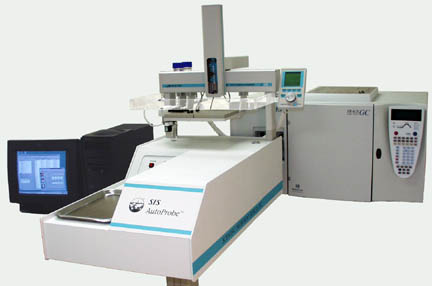
INTRODUCTION
The use of atmospheric pressure ionization (API) mass spectrometry as a routine self-service molecular weight confirmation tool by synthetic chemists has long been established[1]. However, API techniques do not efficiently ionize all organic compounds. Both false negatives and positives may arise due to the discriminatory nature of API, leading the chemist to incorrect conclusions about the state of the reaction. False negatives, where the desired product fails to sufficiently ionize, may lead the chemist to think that the reaction yield is unacceptably low; false positives, where the target compound ionizes more efficiently than the starting material, may erroneously be interpreted as evidence that the reaction has reached completion[2].
Chemical ionization (CI) and other gas-phase techniques offer more energetic ionization, an advantage for less polar compounds with a lower probability of ionization in solution. However, sample introduction for CI has commonly relied upon manual direct exposure probes, which require operation by a specialist at a high cost in time to both the chemist and the analyst.
Automated direct probes have been developed [3-5], but thus far have not included the software component essential for true self-service operation.
A novel automated probe inlet device has been developed, which is controlled by open access software
(Thermo Finnigan Xcalibur), and interfaces with a commercially available mass spectrometer
(Thermo Finnigan Trace-MS). The system comprises a CTC LC/PAL autosampler and automated desorption chemical ionization (DCI) probe with pneumatically actuated vacuum lock.
Relative to open-access GC approaches, the automated DCI probe enables analysis of compounds in a broader volatility range and with less probability of thermal decomposition. This device enables relatively universal molecular weight confirmation for small molecules by the non-specialist.
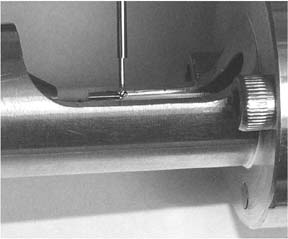
PRINCIPLE
In the Desorption Chemical Ionization inlet technique, a drop of solution containing analyte is deposited on a metal filament and evaporated. The filament is then inserted into the ion source and heated to evaporate the sample. Reagent ions present in the ion source (e.g. NH4+, C4H9+ or free electrons) impart a charge to the analyte molecules; the mass spectrometer then measures the mass-to-charge ratio (m/z) of the resulting ions.

Instrument Setup I. Independent control of two autosamplers and two inlet devices requires either two COM ports and two external 9-pin switching devices, or a total of four COM ports. We added an ISA card containing two additional COM ports (MultiTech #ISI552PC) to the TraceMS Control PC (IBM NetFinity 3000). A separate PC may be used for sample login. LC/PAL currently uses the A200S driver in Xcalibur.
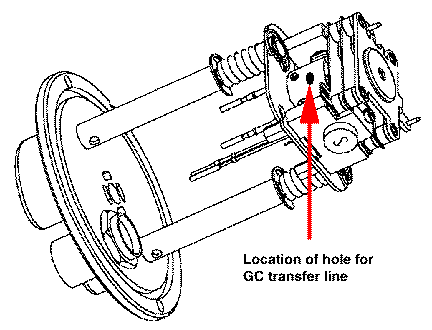
Instrument Setup II. ThermoFinnigan provides separate ion sources for probe and GC inlets. A hole for the GC transfer line may be drilled in the Probe EI/CI Ion Source Block (part #C587A) in order to permit use of both GC and probe inlets without breaking vacuum. Compromise in CI performance appears to be minimal.
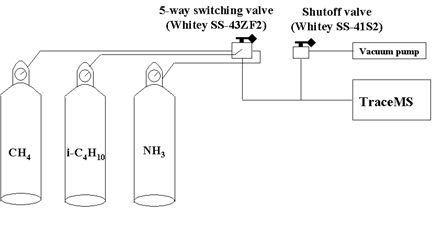
Instrument Setup III. It is convenient to route CI gases through a central switching valve. Reagent gas may be changed in less than 5 minutes with vacuum purge.
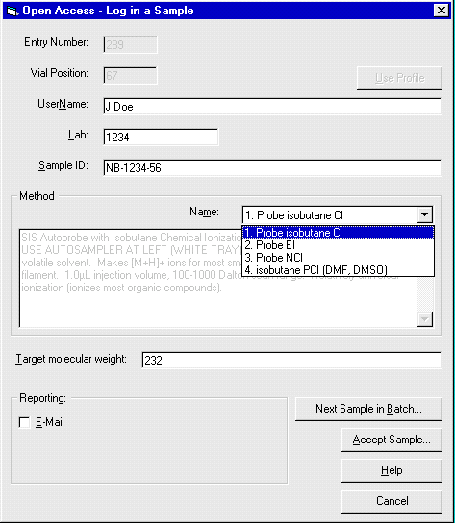
PROCEDURE
The customer dissolves the sample in a volatile solvent, and enters his name and sample description at the login screen. A menu of experiments may be presented (EI, positive-ion or negative-ion CI). Solvent evaporation parameters, DCI current ramp and processing parameters may be independently set for each method. Sample history is documented in an Access database.

Robustness of Autoprobe / Trace-MS EI/CI System
1. Runs ~250 samples/month, capacity much higher
2. Source cleanings about every 1000 samples
3. Burned out 1 DCI filament in five months
4. Fully automated--runs nights, weekends

Advantages of electron / chemical ionization with Autoprobe
- Fast analysis time (~ 2 min)
- More energetic ionization than API (useful for low polarity compounds)
- Compatible with aprotic solvents, chemically reactive compounds
- May use either positive- or negative-ion polarity
- Unattended by specialist
- Choice of reagent gases provides selectivity
- EI spectrum provides "fingerprint", library-searchable
- Instrument stops when error condition is encountered (filament burnout, sample not present)
- Results delivered in either Word 97 or hard-copy format
- With minor source modification, Xcalibur open access MS may be configured for either GC or Autoprobe inlet on TraceMS without breaking vacuum
- Robust operation (>250 samples / month)

Limitations of Autoprobe
- Extremely volatile compounds may be "lost" (but often suitable for GC)
- Thermally labile compounds may decompose
- CI gas not user-selectable (requires operator intervention)
- M/z limit of Trace-MS is 1000
- Full autosampler control lacking due to lack of fully functional software driver for LC/PAL
- Open-access software not tolerant of misplaced vials
Conclusion
The SIS Autoprobe / ThermoFinnigan Trace-MS combination has proven to be a reliable, robust and convenient tool for molecular weight confirmation by EI or CI in the open access mode of operation. The ability to control the analysis with open-access ("no-brain") software makes this combination unique and significantly more productive than previous EI/CI instruments. The instrument has been made available to a community of > 100 untrained chemists for reliable walk-up use. Current use is > 250 samples per month, and growing as chemists learn what OA-DCI/MS can do for them.
A growing number of chemists are now finding that EI/CI analysis can now be performed in an open access environment as easily as the well established flow injection API-MS.
References:
1. Pullen, F.S. et al, J Am Soc Mass Spectrom 1995, 6, 394-399
2. Czarnik, Anthony W., Anal Chem 1998, 70(11), 378A-386A
3. Heinrich, H. et al, Anal Chim Acta 1979, 112, 123-132
4. Martin, D.J. et al, Biomed Environ Mass Spectrom 1989, 18, 733-737
5. Huang, N. et al, J Am Soc Mass Spectrom 1999, 10, 1212-16
Trademarks:
Netfinity is a trademark of IBM Corporation.
Trace-MS, Trace-GC and XCalibur are trademarks of ThermoFinnigan Corporation.
AutoProbe is a trademark of Scientific Instrument Services.
Multitech is a trademark of Multi-tech Systems, Inc.
LC/PAL is a trademark of CTC Analytics, AG.
Whitey is a trademark of the Swagelok Company.
Sigma is a trademark of Sigma-Aldrich Corporation
Word 97 is a trademark of Microsoft Corporation
Access 97 is a trademark of Microsoft Corporation


